Suspended high ceiling in the kitchen. Installation of a false ceiling from plastic panels. Photo examples of the design of suspended kitchen ceilings
The desire to have excellent finishes for all rooms in the house is quite logical - a huge range building materials on the market allows you to realize any ideas of designers and consumer requests. A false ceiling in the kitchen is not uncommon, especially since you can build it yourself at minimal cost. The room takes on a stylish look, and behind a simple design, you can even hide telecommunications - electrical cable, telephone wires, etc.
Design features
The design of the false ceiling includes the following elements:
- metal frame fixed on the floors;
- modular parts that form the ceiling surface itself.
Between the two planes (old and new ceiling base) engineering television and radio communications and lamps are freely placed. It is this feature that served as the name of the false ceiling false ceiling design.
In the manufacture of modular elements, the form of plates, cassettes, rails or panels is most often used. Raw materials for their production can be any:
- glass or mineral fiber;
- steel, aluminum;
- reinforced gypsum, drywall;
- wood;
- plastic;
- DSP, MDF or fiberboard.
Modern technologies make it possible to finish the ceiling even with a laminate.

Main advantages suspended structure:
- excellent disguise of the old coating or ceiling irregularities;
- the possibility of complete or partial replacement of electrical wiring hidden in the ceiling "pie";
- easy access to utilities;
- energy efficiency while improving the reflective characteristics of the upper plane of the room;
- speed of installation;
- availability and reasonable cost of materials.
Types of suspended ceiling structures
Based on used for manufacturing ceiling elements The constructions arranged with their help are of several types:
- cassette;
- rack;
- lattice;
- tiled;
- cellular;
- panel.
The most common are tiled and panel suspended ceilings for the kitchen. The panels are put on a pre-prepared frame, the color of such elements is initially white. If desired, the owners can paint the structure in any color.
In addition to the types listed above, suspended panel ceiling structures can be unusual, for example glass with photo printing. On the T-profile glass panels are attached, on which a photograph is printed or any picture you like is pasted from the film.
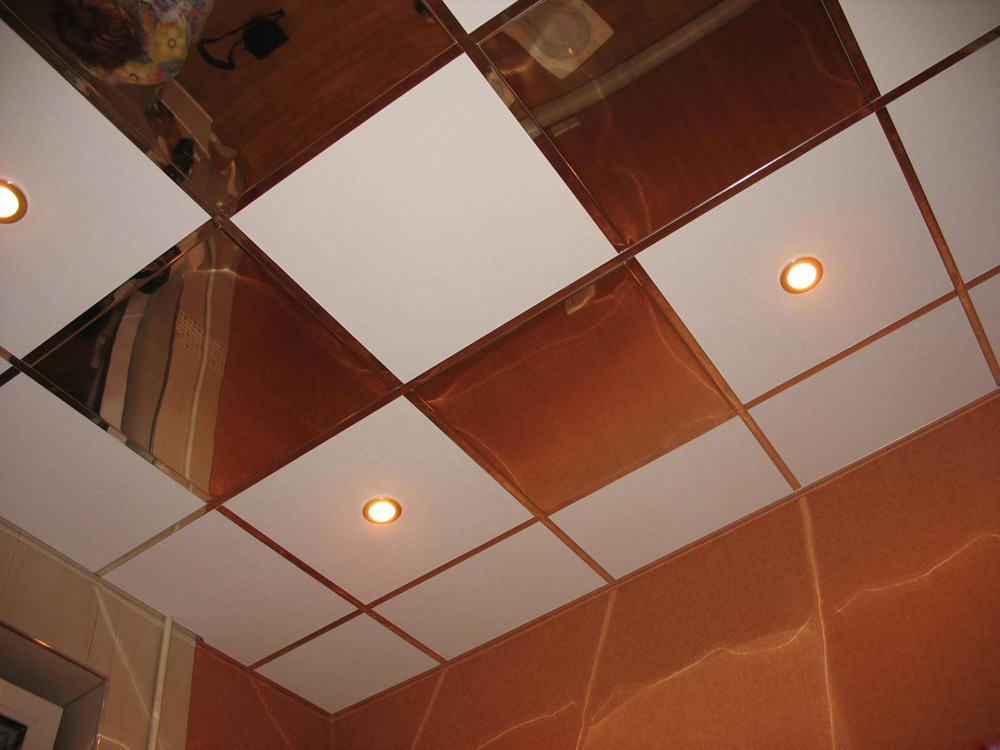
Cassette ceilings are made of steel or aluminum cassettes. square shape. In this case, the panels can be painted in any color. The main advantages of such structures:
- long service life;
- increased moisture resistance;
- the possibility of repeated dismantling;
- perforation provides good ventilation;
- pasting cassettes with any noise-isolating and heat-saving material;
- variety of textures: smooth surface, applied ornament;
- convenient access to utilities.
Modern mirror ceilings from cassette elements - latest achievement in the field of design. By applying an unusual pattern or spraying matte or glossy surface design allows the rays of light to play whimsically in the space of the kitchen. Cons of mirror false ceilings:
- visual and real narrowing of space;
- complex installation and maintenance;
- even a slight coating of dust immediately catches the eye;
- expensive pleasure.

The mirrored ceiling will create the feeling of having a “Second Light”
The next view is metal suspended ceilings in the kitchen. These structures are excellent technical specifications. Such structures have the following advantages:
- resistance to temperature changes and moisture;
- light weight of fragments and frame;
- ability to withstand a significant load.
Aluminum ceilings for the kitchen are panel, slatted and with decorative lattice trim. Protective covering anodic oxide or high-quality varnished fragments may or may not have perforation. For painting panels and rails, powder dyes made from polyester resins are used. The rest of the parts and fasteners are made of steel and coated with zinc.
Rack ceilings are divided into 2 large groups:
- open - elements of the same color as the base itself are inserted into the gaps of the frame. The result is a single-color ceiling canvas. By combining colors, you can achieve conditional zoning of the kitchen;
- closed - special rails and butt joint technology are used to fasten the panels.
Panels on slatted suspended ceilings are also of 2 types: German with rectangular fragments for structures open type and Italian style with rounded edges and closed version mounts.

Reiki can be white or colored: elegant silver, luxurious gold or trendy mirror. In rack ceiling structures it is convenient to mount lamps, mount complex chandeliers or minions. The service life of such panels is at least 2 decades. In addition to durability, rack ceilings have other advantages:
- combination with any kitchen style and footage;
- reliability;
- use of quality materials;
- unlimited scope for designer ideas;
- environmental Safety;
- ease of care;
- hygienic: they are not afraid of mold and do not collect dust;
- high resistance to fire and water;
- great accommodation internal systems ventilation, electricity, etc.;
- high reflective characteristics;
- assembled in 2-4 hours.
The variety of shapes and textures of the elements used in slatted ceilings makes the kitchen individual, having its own face. But such structures also have their minus - the lack of the possibility of partial dismantling.
The next material for the construction of a false ceiling is drywall. This inexpensive raw material can be used to create structures with complex geometries and different number levels. Perfect surface leveling is the main advantage drywall sheets, sold in dimensions of 1.2 x 2.5 meters and 10-15 mm thick. The option with drywall construction is definitely the cheapest, available to any master.
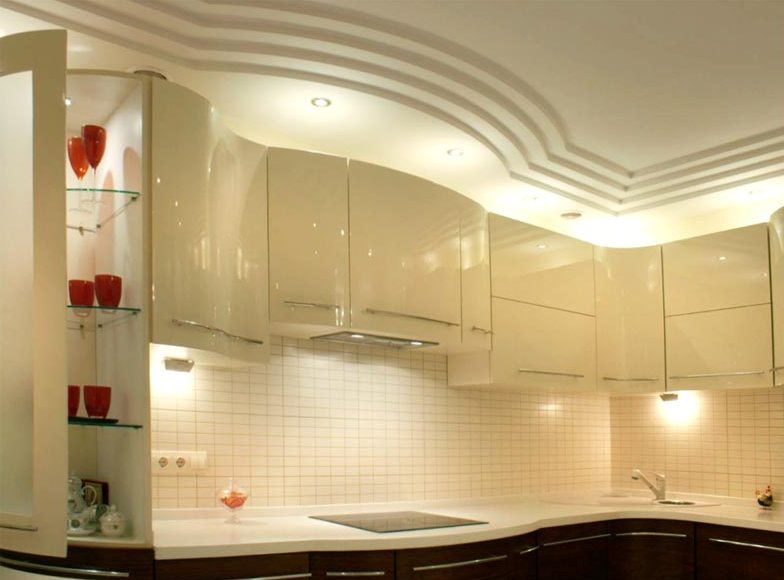
Important: when choosing drywall for the ceiling, it is necessary to give preference only to moisture-resistant models. The service life of this material is 20 years or more.
Advantages of plasterboard kitchen ceilings
The unique flexibility of drywall sheets is just a godsend for interior designers: it is possible to form cavities and protrusions of any shape and size from the material, it is easy to mount all kinds of lighting inside. On the stage finishing plasterboard suspended ceiling is pasted over, lined or painted - there are a lot of options. It is about this type of suspended structure for the kitchen that is most in demand on the market today and it is worth talking in more detail.
Suspended represent the optimal design in the ratio of design-quality-price concepts. The speed of construction is ahead of any other models of suspended ceilings, and the level of complexity of work is available even to a novice master.
The kitchen has ceased to be a place where only cooking and eating is done. Increasingly, the interior of the kitchen is equipped so that the room is comfortable and cozy. Today you won't surprise anyone quality repair, exclusive design, modern household appliances. The ceiling is the most visible part of any room. Suspended ceilings can serve as an ideal solution for the kitchen. Suspended ceilings in the kitchen will help to hide all the irregularities of the ceiling, mask communications, and reduce the noise level in the room. Such ceilings provide complete freedom to design ideas, allow you to install all kinds of built-in lights, create a mosaic pattern, make a multi-level ceiling.
Unusual view the kitchen is able to give a cassette false ceiling
Advantages of suspended ceilings in the kitchen
Many people absolutely in vain refuse to install suspended ceilings, explaining this by the fact that the room is too low. Actually glossy ceilings visually increase the cubic capacity of the room, expand the space, “add” the kitchen a few centimeters in height. Due to their surface, they create an optical illusion, since the reflective properties of glossy ceilings are very high, they can be installed in small and dark kitchens.

original lines multi-level ceiling from drywall will definitely become main detail room decor
False ceilings look good in small but very high rooms. Suspended ceilings help to remove the imbalance, "taking" a few extra centimeters of height. In addition, the ceiling will appear much lower if it is hand painted or made in rich color.
Very often the ceiling needs to be “raised”. False ceilings solve this problem very simply. Looks interesting combined multi-tiered ceilings when one tier is made in a light pastel or white color, and its middle is made out with a stretch printed cloth. This option is economical: the frame is made of drywall, and the middle is made of a seamless canvas, which only takes a few meters. Suspended ceilings have a neat appearance, hide surface irregularities, are durable in operation and easy to maintain.
How to choose suspended ceilings for the kitchen
When choosing a false ceiling, you need to be guided by two simple rules. First, pay attention to the appearance and hygiene parameters ceiling material, secondly, on the complexity of caring for him. For the kitchen, you need to choose ceilings with a washable surface. These include suspended ceilings made of PVC film and seamless ceilings. Smooth surface the material is not clogged with grease and soot, because ordinary dust does not even accumulate on such ceilings. This is due to the structure and texture of the material. They are hygienic, do not collect condensate, are easy to clean, and do not interfere with natural air exchange.

The ceiling with a built-in lighting system is one of the most common ways of lighting, popular due to its practicality.
Additional ventilation in the kitchen great importance. The possibility of embedding this system makes false ceilings ideal option for decorating the kitchen. Design idea allows you to position the ventilation grilles so that they even decorate the interior. Worthy of special attention lighting. Lamps built into the kitchen wall give a lot soft light which makes working in the kitchen especially enjoyable. Except standard features built-in lamps arranged in a certain order will give the interior originality and special style.
When choosing wooden suspended ceilings, it should be taken into account that the wood will be exposed to steam, moisture, and soot on a daily basis. They belong to the elite class, combine individuality and respectable appearance. At proper care wooden ceilings durable, but still it is recommended to choose a different material for the kitchen, although many designers prefer wood.

The rack ceiling looks simple, without frills, but it is very practical and easy to use.
Budget option for arranging suspended ceilings in the kitchen is plastic. It is easy to install and operate, easy to clean, durable. Plastic ceilings are resistant to moisture. In case of flooding, no stains remain on the ceiling, water slowly drains from the cracks at the junction of the sheets. The plastic ceiling is very easy to clean. White ceilings need wet cleaning 1-2 times a year. If you choose a ceiling in beige colors, then pollution on it will almost not be visible. In this case, the ceiling can be wiped with a cloth with soapy water or special solution once every 1-2 years. Plastic perfectly hides all the flaws of the ceiling. Even with a bevel of 10 centimeters, plastic ceiling perfectly masks this shortcoming. The only disadvantage of this material is its fire hazard. When ignited, it emits soot, smokes strongly, turns black. Many do not pay attention to this quality at all, because the main factor that becomes decisive is the price.
Gypsum suspended ceilings in the kitchen allow you to decorate the surface of the ceiling in different architectural styles. The advantage of gypsum is that it is a fire resistant material, which is so important in the kitchen. plaster ceiling easy to paint, has good sound insulation from extraneous noise. It is easy to hide various communications, ventilation, and mount lighting fixtures in it. Gypsum is easy to install, lends itself to the desired deformation, which allows you to make a multi-level ceiling, with various transitions. The relatively modest price makes this material one of the most popular in the construction industry.
When choosing the material of the canvas, you need to pay attention to the manufacturer. Tests show that Chinese suspended ceilings can withstand 500 wash cycles, while ceilings from European manufacturers can withstand up to 1000 cycles. Saving 20% on the cost of low-quality ceilings, you can lose half of its life.
Photo examples of the design of suspended kitchen ceilings
If you are interested in suspended ceilings, then you can get acquainted with various models and design solutions. Look at the suspended ceilings in the kitchen, photos will help you decide on the type of ceiling that is suitable for your room. After reviewing the examples of ceilings, you can choose specific model, type of canvas, and bring the idea of repair into your interior.

Suspended ceilings can zone the space and often it is this, and not a decorative function, that is decisive.

The original drawing, placed on the suspended ceiling, is able to completely transform the room, creating a wonderful mood day by day.

A calm, unobtrusive image on the ceiling will not only decorate the room, but also create a feeling of peace and tranquility in the kitchen.

Suspended ceilings in the kitchen are successfully combined with stretch ceilings, turning into a unique spectacular composition.

Spotlights will add a simple rack ceiling elegance and decoration

Due to plasticity and ductility stretch ceilings and drywall, ceiling structures can be given the most daring shapes and lines
Plasterboard suspended ceilings in the kitchen today are one of the most common ceiling finishes. They are relatively inexpensive, reliable, practical and easy to decorate according to the technology of your choice, whether it be painting, wallpapering or decorative plaster. In addition, the suspended ceiling is quite simple to manufacture - and this is perhaps its main advantage.
Suspended ceiling: what is it good for?
Despite the fact that suspended ceilings have been installed relatively recently, in just a few decades they have gained serious popularity both among craftsmen and owners.
What is the reason for this attitude?
- perfectly hides all the irregularities ceiling plate(and in panel houses such irregularities are quite significant) and provides a quick leveling of the ceiling.
- The installation of a false ceiling makes it possible to proceed with minimal preparation to decorative trim ceiling. Where you would have to apply several layers of plaster to the ceiling to eliminate irregularities, it will be enough for you to putty the seams between the drywall sheets.
- Inside the false ceiling, you can hide the housings of the lamps and the wiring from them, so that you will not need to either fix the wire on the ceiling or drill strobes in the concrete.
- The simplicity of the technology for arranging a suspended ceiling allows you to make multi-level structures complex shape. So in terms of design, suspended ceilings are a real find for the kitchen!

This very impressive list of advantages makes it quite attractive - especially since almost everyone can install them on their own.
Do-it-yourself false ceiling installation
Tools and materials
So, you have decided to mount a suspended ceiling yourself.
For this we need:
- Drywall sheets
- Metal profile for the frame (two types - start and main)
- Suspensions on which the profile will be attached to the ceiling plate
- "Crabs" - metal jumpers connecting the parts of the frame at the intersection of profiles
- Fasteners (dowels for fixing the suspension, self-tapping screws "bugs" for fastening the profile, self-tapping screws for drywall)
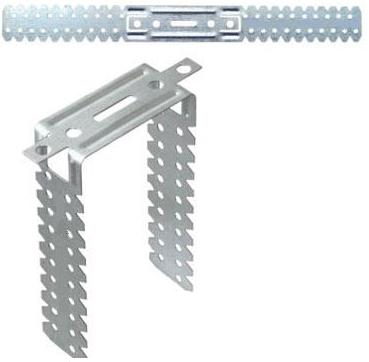
Of the tools you will need to purchase:
- screwdriver
- Perforator
- Drywall knife (or fine toothed saw)
- Laser level
- Roulette
When everything you need is at hand, you can start marking the installation of the ceiling.
We apply the markup
Marking the ceiling for installation hinged system includes:
- Drawing a baseline- around the perimeter of the entire kitchen at a distance of 100-150 mm from ceiling.
Such a distance is most often quite enough to hide the wiring, communications and embedded housings.

Note! If you are installing a multi-level suspended ceiling, then the indentation for each level is calculated individually, depending on the design and construction you have chosen.
- After drawing the baseline, we go to the very plane of the ceiling, where we mark up for the placement of the frame.
The marking step depends on the dimensions of the drywall sheets you purchased, but experts do not advise making it more than 50 cm.
Once the markup is applied, you can begin to fix the frame and sheath it with drywall sheets.
We mount the frame
The frame on which suspended ceilings are assembled is a system of metal profiles, rigidly fixed to the ceiling of the kitchen.

We fix the frame according to the following algorithm:
- We begin the installation of the frame by fixing the starting profiles. We attach the profiles to the walls along the baseline, leveling using a laser level.
To fix the starting profile, we pre-drill holes in the kitchen wall, into which we then hammer the fixing anchors. - Then we proceed to the installation of the main part of the frame. According to the markings previously applied to the ceiling, we fasten the suspensions (we use the same dowels as in the previous case), we bend the suspensions in the shape of the letter “P” and already to them with the help of self-tapping “bugs” we fasten the main profile (it is sometimes called rack).
Note!
For multi-level ceiling or for a false ceiling located at a great distance from the ceiling plate, a standard suspension may not be enough.
In this case, a rod-shaped suspension with a fixed bracket is used.
- We attach the ends of the rack profile to start profile.
- Where rack profiles intersect, install "crabs" - to fix the node.

Our frame is ready. It's time to start final stage- Plasterboard ceiling sheathing.
We sheathe the ceiling
For the final stage, we need the help of a partner, since at the same time holding a drywall sheet and screwing it to the profile is very inconvenient.

Before installing the sheets on the frame, it is necessary to cut holes for fixtures in the right places, and grooves for pipes.
We carry out the sheathing according to the following scheme:
- Raise the cut-to-size sheet of drywall and press it against the frame.
- Align the sheet so that it is as evenly oriented as possible.
- Using self-tapping screws wide hat, fasten the drywall to the profile, sinking the heads of the self-tapping screws.

Note!
For convenience, it is better to use a screwdriver with a magnetic nozzle - this way you will save a lot of time searching for fallen screws.
- We join drywall sheets almost closely, leaving only a minimal gap - we will fill it with putty mass when leveling the ceiling for painting or pasting.
We putty the ceiling sheathed with drywall sheets with high quality, paying special attention to leveling the fasteners and sealing the joints. The plastered suspended ceiling is ready for finishing!
It is by this technology that false ceilings are made for the kitchen. Naturally, to obtain the desired result, you will have to make efforts and diligence, but if you prepare well, you can mount the suspended ceiling quite quickly!
Today, many options have been developed for decorating the ceiling in the kitchen. In the kitchen, materials that are not appropriate in other living quarters will harmoniously fit into the interior. Today you can find traditional hinged structures in the kitchen made of plasterboard, simply plastered surfaces or ceilings made of exotic materials intricate outlines.
Materials for suspended kitchen ceilings
Housewives perceive the kitchen as a testing ground for their creative fantasies. Therefore, often in the kitchen, the decoration is not made with one kind of material, but is a mix different designs and textures. The owners are trying to diversify the boring flat ceiling with a hinged structure.
The hinged structure is a frame sheathed decorative material. It is this material that gives the name to the whole structure. The frame itself is made of a metal profile or a wooden slat. According to the material that is used for sheathing, the following types of hinged structures can be distinguished:
- plastic;
- With the use of laminated panels;
- From plaster moldings;
- Wooden lath, lining;
- Aluminum slats.
Rack wooden
If the kitchen serves as a dining room, where food is not prepared around the clock, but the whole family gathers for a pleasant tea party and long conversations, a wooden slat suspended ceiling would be appropriate. For the kitchen, this material is impractical, as constant steam and soot will quickly spoil appearance lining. But in the dining room, it looks organic and respectable.
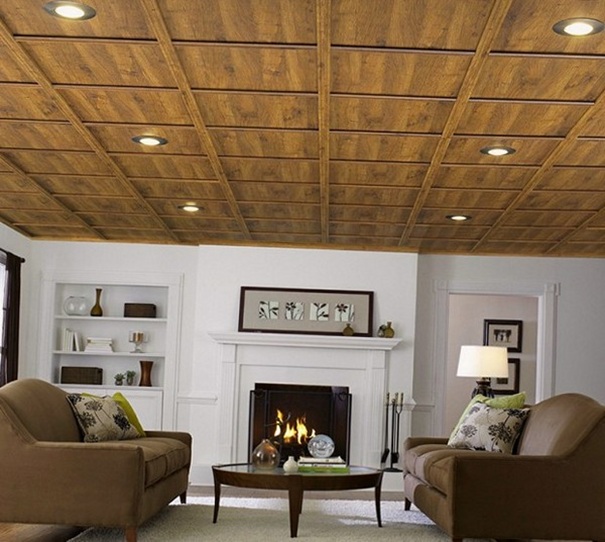
On the ordinary kitchen, where the hostess spends a lot of time cooking, the rack structure is made of aluminum lamellas. But a ceiling completely wired with such a rail radiates cold, so it is combined with a stretch or panel structure made of drywall, plastic. In such a composition, the rack structure will stand out and become an original highlight in the interior.
The rack sheathing is attached to the crate. It is also made from a thin rail or a metal profile is taken.
Plastic materials
At the time when plastic appeared on the construction market, it became the main material for suspended structures. It is cheap, practical and stylish material. Its installation does not require any special equipment or building skills. White is often installed in the kitchen plastic lining. It lasts for a long time kitchen fat and soot are easily and completely wiped off its surface.
In the event of a water supply failure, the only structure that will not suffer from this will be a suspended plastic ceiling. For practical reasons, the hostesses do not use a pure white lining, but take it with light shades of beige or gray. Due to this, the frequency wet cleaning is shrinking.

In addition to lining, plastic panels are used for filing a hinged structure.
The plastic sheathing has joints, but they become part of the design of the structure. To create the appearance of an extension narrow space, sheathing is performed in such a way that these strips are located along a short wall.

Plastic does not emit toxic substances into the atmosphere. The only thing is that after installation, a specific smell is felt in the room for some time. But it does not pose a health risk.
Drywall
Drywall gradually displaced plastic from the leaders in the use in the decoration of hinged ceiling structures. This material is easy to mount and process. Due to its pliability, it is made different types simple and geometrically complex suspended ceilings.
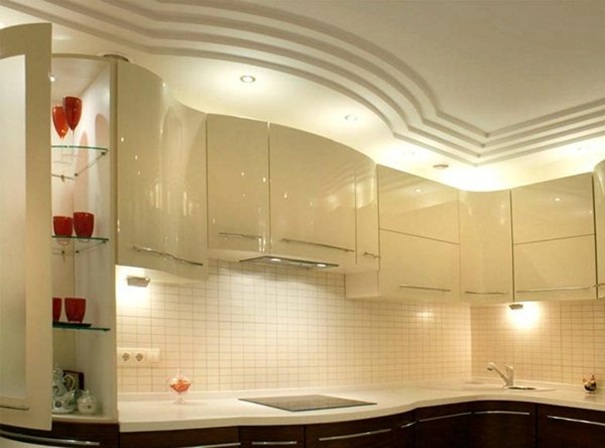
Even if the hostess does not pursue the goal of creating something exclusive, but wants to level the ceiling, then drywall is chosen. With it, you quickly get flat surface, hiding under it all the electrical wiring along with crumbling plaster. Paints for painting drywall varying degrees moisture resistance and the widest palette. Moisture-resistant drywall in combination with latex paints will last a long time in conditions high humidity in the kitchen.
Stretch ceilings, modular ceilings
Modular ceilings have become an integral attribute of administrative premises, so they are rarely installed in kitchens.
The new stretch ceiling technology is making its way into the kitchen as well. Any photo gallery where manufacturers demonstrate all the variety of stretch ceiling designs will provide the hostess wide opportunities fantasize with design options. In addition to new design features, stretch fabrics turned out to be practical in the kitchen. PVC film is resistant to moisture and does not absorb kitchen odors and is easy to keep clean.

The mirror shine of glossy canvases will expand the space, and unlimited possibilities for combining colors and their shades, the use of photo printing have led to the widespread use of tension structures for finishing kitchen ceilings.
Matte and satin canvases - all these types give wide selection to create warm atmosphere. Bright glossy ceilings will enliven and add light to a darkened kitchen with a lack of natural light.
If family members run into the kitchen occasionally, only for meals, then there is no point in trying especially hard with the design of the ceiling. But if it matters workplace hostesses, and the kitchen atmosphere will directly affect the mood, it is worth dreaming up and coming up with an original interior.
Hanging structures in the kitchen and examples of interiors
 Mounted structures — perfect solution for kitchens
Mounted structures — perfect solution for kitchens 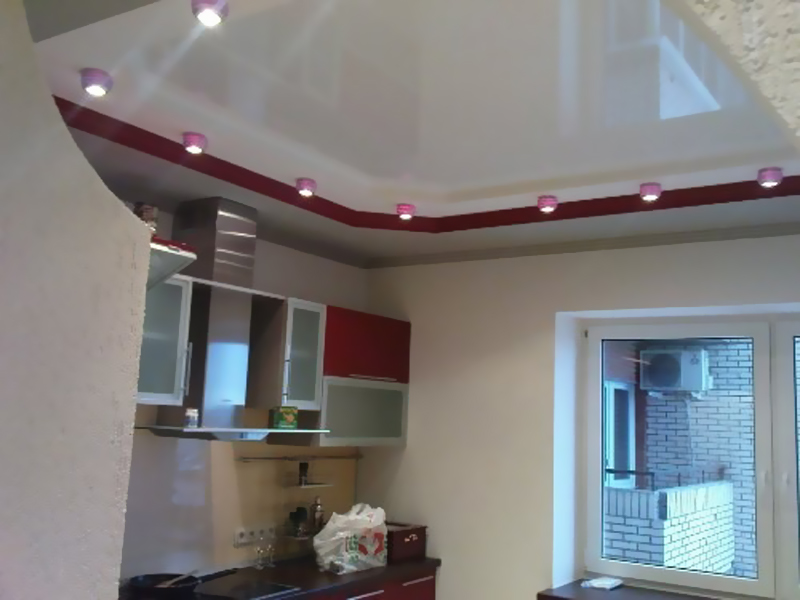 Beautiful and graceful
Beautiful and graceful  Design ideas No limit
Design ideas No limit 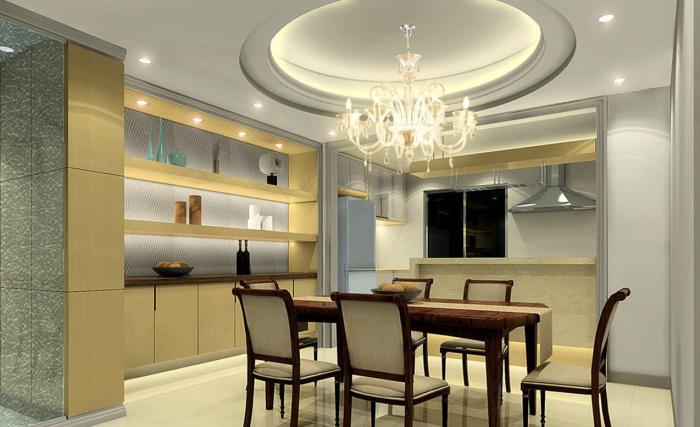 Accentuate the central part of the ceiling
Accentuate the central part of the ceiling  Layered structures
Layered structures 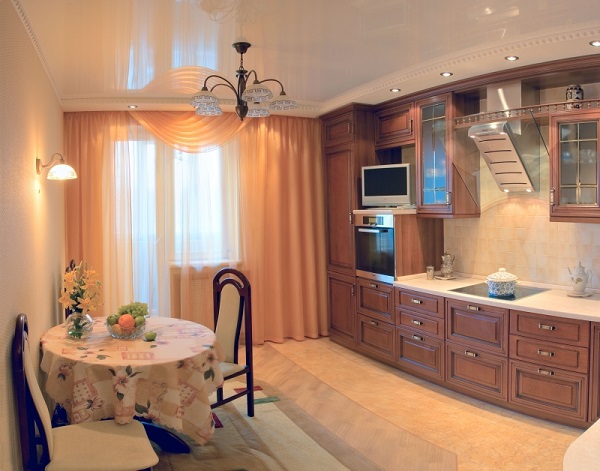 Interior transformation
Interior transformation  Combined systems
Combined systems
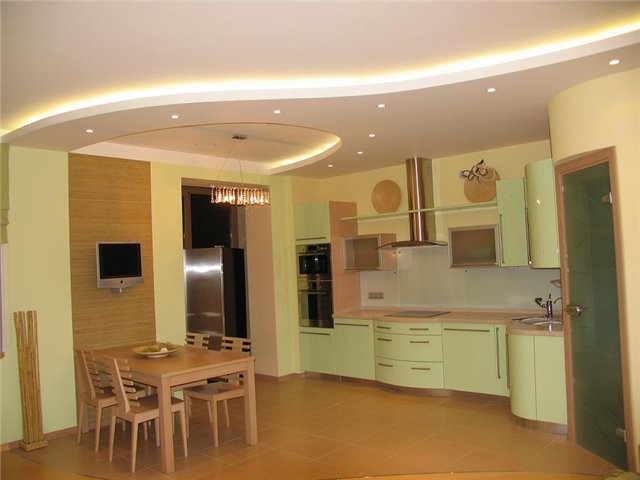 hinged type installation
hinged type installation  Excellent design with hidden lighting
Excellent design with hidden lighting